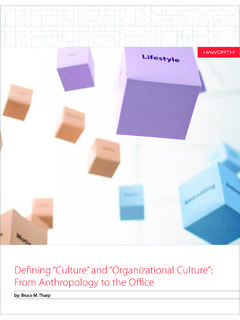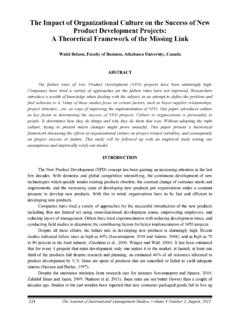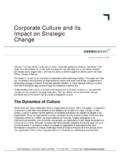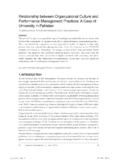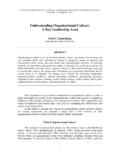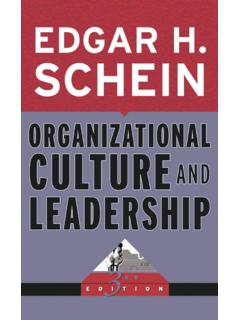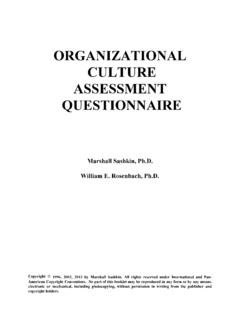Transcription of Defining “Culture” and “Organizational Culture”: From ...
1 Defining culture and organizational culture :From Anthropology to the Office by: Bruce M. Tharp2 Defining culture and organizational culture : From Anthropology to the O ice / culture of an organization eminently influences its myriad decisions and actions. A company s prevailing ideas, values, attitudes, and beliefs guide the way in which its employees think, feel, and act quite often unconsciously. Therefore, understanding culture is fundamental to the description and analysis of organizational phenomena. For some, culture is considered the glue that holds an organization together and for others, the compass that provides direction. These are but two of many such metaphors ( , magnet, lighthouse, exchange-regulator,affect-regulator, need satisfier, sacred cow), illustrating that organizational culture is indeed very important, but whose definition is slippery and often contested.
2 Usually the domain of top executives and upper-management, for most within an organization its culture remains implicit often with only its effects and implications discussed. Despite this, as decades of research suggest, an explicit, integrated, accepted, and consistent organizational culture seems important in achieving long-term health and other performance successes. Yet, as in most arenas of social science where the intricate webs of various and varying human influences exist, distinct and conclusive causal links are difficult to establish. Keeping this in mind, it is still very likely that the richness and dynamism of organizational activity the life of an organization may be seen, and therefore shaped and improved, through the lens of Origins of culture What exactly is culture ? Unfortunately a fixed, universal understanding does not exist; there is little consensus within, let alone, across disciplines.
3 Often culture is applied so broadly, merely as social pattern, that it means very little. Highly specific, idiosyncratic definitions also abound where the term is used in various contexts in support of any culture first appeared in the Oxford English Dictionary around 1430 it meant cultivation or tending the soil, based on the Latin culture . Into the 19th century culture was associated with the phrase high culture , meaning the cultivation or refinement of mind, taste, and manners. This generally held to the mid-20th century when its meaning shifted toward its present American Heritage English Dictionary definition: The totality of socially transmitted behavior patterns, arts, beliefs, institutions, and all other products of human work and thought. Aspects of culture INVISIBLE VALUE . ATTITUDE . ASSUMPTIONS . BELIEFSThe topic of organizational culture is increasingly understood as a company asset that can be used to increase business performance.
4 While important, organizational culture is a slippery concept to concretely define. This paper deals with the historical development and foundational understandings of both the term culture , from anthropology, and its appropriation by industrial organization researchers to organizational culture . A foundational definition by Edgar Schein of MIT s Sloan School of Management is arrived at as well as the notion that culture can be observed at three levels of the organization: artifacts, espoused values, and basic : Anthropological Origins of culture Understanding culture Origins of organizational culture Understanding organizational CultureFor some, culture is considered the glue that holds an organization together and for others, the compass that provides :EMPLOYEE DRESSPRODUCT LINESIGNAGEPUBLICATIONSINTERIOR ARCHITECTUREFURNITUREBEHAVIORS:FINANCIAL REPORTINGHIRING / FIRING PRACTICESEMPLOYEE TRAININGRECYCLING PROGRAMS3 Defining culture and organizational culture .
5 From Anthropology to the O ice / the dictionary definition helps to close in on its meaning in general parlance, the term is also used by many disciplines in unique ways. To move toward a more specific and applied understanding of culture , anthropology can be helpful. It is this social scientific discipline that has contributed the most to its practical application within the field of organizational research. Originally the notion of culture described the rituals, myths, languages, values, beliefs, and practices of distant peoples often in exotic places the objects of traditional anthropological inquiry. Even within the field however, numerous approaches to culture abound as evident in one seminal 1952 study that identified 164 different anthropologist Edward Tyler is widely credited with the first (1871) modern definition of culture : that complex whole which includes knowledge, belief, arts, morals, law, custom, and any other capabilities and habits acquired by man as a member of society.
6 Undoubtedly this definition influenced the shift toward current dictionary definitions. Subsequent to this new interpretation and vision of a complex whole, academics attempted to build upon this by creating universal lists of all of the elements of culture , the most exhaustive of which (first published in 1938) lists 79 major divisions and 637 subdivisions. While comprehensive and still useful for social science researchers today, it is ineffectual for most general applications as well as corporations and other CultureWhile the complexities of the culture concept were being debated in the mid-20th century, surveys of its different definitions yielded a few common threads that are helpful in organizational research. Most simply, culture involves three basic human activities: what people think, what people do, and what people make. Further, several common properties arise: culture is shared, learned, transmitted crossgenerationally, symbolic, adaptive, and speak of culture as being shared narrows the field of relevant activity to that which is common and social.
7 A particular action is not cultural if it is unique to one or relatively insignificant number of individuals. Also, culture is learned (actively or passively) and is transmitted cross-generationally through formal or informal social interaction we are not born with the understanding that stealing is wrong or that diamonds show you care. One of the primary characteristics of human life, over animal life, is that we assign symbolic meaning to ideas, behavior, and objects, as well as have language and speech. We say that humans have culture while animals do not. This is largely due to their inability to ascribe arbitrary symbolic meaning to their world a chimpanzee could not designate his banana to signify honesty, for example. culture is also adaptive in that it can and does change in response to various influences and conditions. No culture is truly static many aspects of American culture are radically different in the wake of the Internet, the dot-com bubble, and global terrorism.
8 And finally, culture is integrated in the sense that it permeates society and becomes part of the social machinery. culture is the ever-present, ethereal medium in which members live and through which they 1973 anthropologist Clifford Geertz published, The Interpretation of Cultures, in which he writes: culture is the fabric of meaning in terms of which human beings interpret their experience and guide their action and that culture is an ordered system of meaning and of symbols in terms of which social interaction takes place. This semiotic (symbolic or language based) notion of culture gained great popularity in the postmodern movement of the 1980 s, when the relatively mature discipline of organizational behavior first began to talk broadly about organizational culture . Geertz s anthropological definition was the most cited in the literature at that time and still has great purchase in contemporary of organizational culture The field of organizational behavior and the related discipline of management science began investigating organizations in terms of culture as early as the 1930s.
9 The final phase of the famous Hawthorne studies at the Western Electric Company marked the first systematic attempt to use a concept of culture to understand the work environment. While an important step forward in qualitative research, the investigation was rather blunt and the understanding of organizational culture remained fairly primitive during the following decades. Most mid-century attempts at understanding were conducted by scholars steeped in quantitative psychology and sociology, though by the 1970s researchers more explicitly and emphatically appropriated the theories and methods of anthropology. The late-century upsurge of interest in organizational culture is credited largely to the economic conditions of the 1970s when international competition had heightened and more foreign companies were operating factories in the United States. Specifically, the success of the Japanese in many industries sparked curiosity about For some, culture is considered the glue that holds an organization together and for others, the compass that provides culture and organizational culture : From Anthropology to the O ice / their differing corporate values, attitudes, and behaviors were responsible for their often superior performance.
10 The 1982 publication of Peters & Wasserman s In Search of Excellence stirred both popular and professional interest through its suggestion that organizations with strong cultures were more culture was offered as an asset that could be managed to improve business performance. While definitely the most popular book on the subject (outselling all other non-fiction books for the year), three others were seminal to the development of the field: Ouchi, 1981, Theory Z: How American Business Can Meet the Japanese Challenge Pascale and Athos, 1982, The Art of Japanese Management: Applications for American Executives Deal and Kennedy, 1982, Corporate Cultures: The Rites and Rituals of Corporate Life Since the early 1980s, academic and applied exploration of organizational culture has steadily increased and even now there is little indication of abatement as changes in data management, work organization, values, lifestyles, demographics, knowledge-intensive work, outsourcing, and a host of other social, economic, and technological factors continue to impact the relationship between organizations, workers, and the ARTIFACTS.
